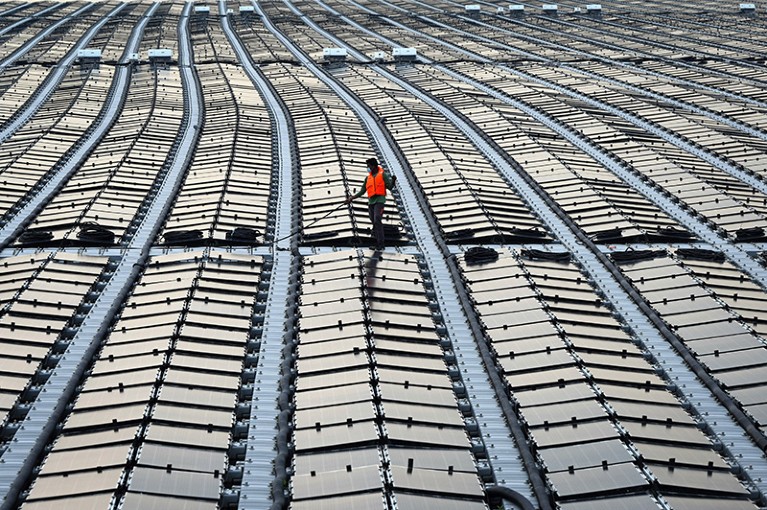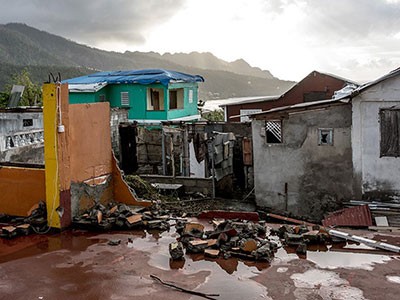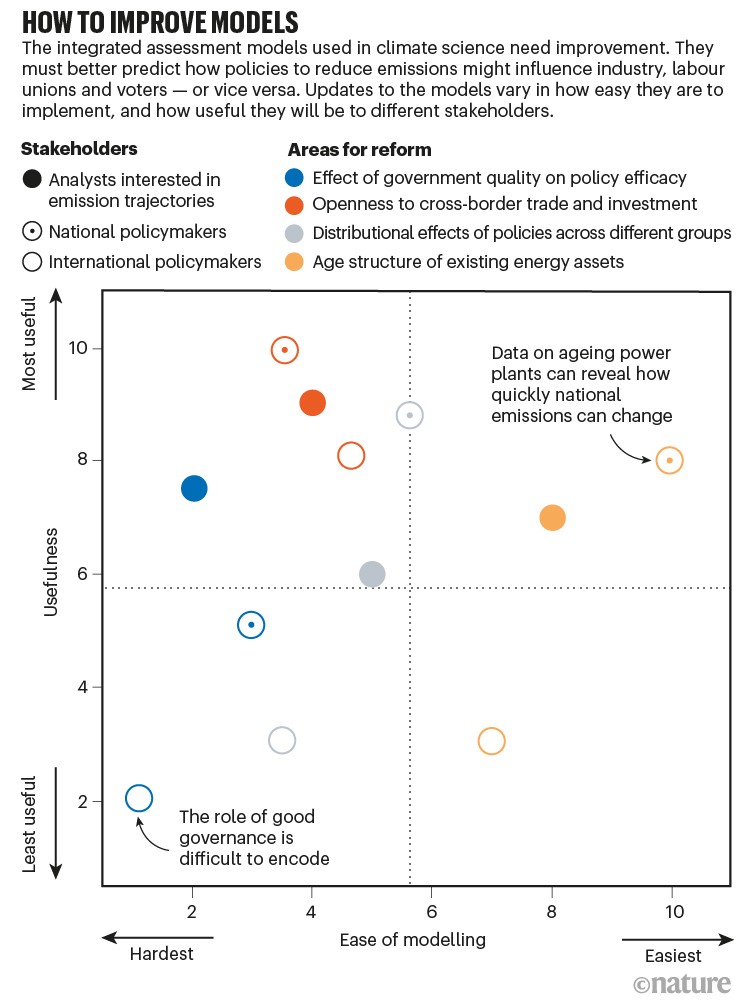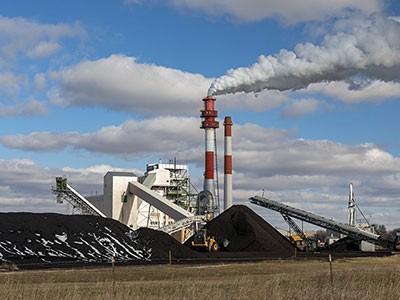
A worker tends to a floating solar-panel farm off the northern coast of Singapore.Credit: Roslan Rahman/AFP via Getty
Political support for decarbonizing the global economy is at an all-time high. The good news is that about two-thirds of carbon emissions come from countries that have committed to reach ‘net zero’ by mid-century — they aim to cut their greenhouse-gas outputs and capture as much as they emit1. The bad news? The computer models that analysts use to assess routes to achieve such goals are missing a crucial factor: politics.
These ‘integrated assessment models’ (IAMs) combine insights from climate science and economics to estimate how industrial and agricultural processes might be transformed to tackle global warming. They’re encoded with knowledge about technologies, such as pollution-free power plants and the cost of electric vehicles. Thus IAMs enable researchers to probe, for example, how a carbon tax might induce big cuts in emissions2, or how a drive to decarbonize the transport sector could shift investments towards greener fuels and electricity.
Yet the models are overly abstract. They don’t characterize the difficult trade-offs that politicians face when they must respond to constituencies, or corporate leaders who must woo investors. In France, for example, a proposed increase to the fuel tax in 2018 was among the triggers of large protests. These saw the government backtrack on a key element of its climate policy. Fearing electoral consequences, many politicians around the world now shy away from carbon taxes and other market-based strategies. They instead rely heavily on regulatory instruments — such as fuel-economy standards — that make the cost of such policies less visible to the public and give politicians more control over who foots the bill3.
National COVID debts: climate change imperils countries’ ability to repay
The story of politics isn’t just one of conservatism and evasion. Support for action can change radically on the back of success. Current IAMs can’t capture this dynamism either. Subsidies for wind and solar energy, for example, have sped up adoption, lowered costs and created industries that have tilted the landscape in favour of more investment in renewables.
To develop politically durable strategies, decision makers need to understand how climate policy creates winners and losers. This means moving IAMs away from jack-of-all-trades models and towards a suite of tailored ones, each tuned to a specific purpose and audience. A negotiator at the COP26 climate-change conference in Glasgow, UK, this November, for example, might want to understand how international trade policies affect global emissions. A national policymaker, however, might need to balance attempts to decarbonize transport infrastructure against election promises they have made to car-factory workers in their constituency.
As a first step, we — a group of political economists and IAM specialists — identified eight key areas in which insights from our disciplines can improve models’ relevance for real-world policy and investment choices (see ‘Eight political economy insights’). We also assessed numerous potential reforms (see ‘How to improve models’ and Supplementary information for a full list of 11 reforms), so that researchers can examine the trade-offs between making models tractable and making them more useful for real-world decisions.

Source: Author analysis
Incentives and trade-offs
Similar to many economic tools developed decades ago, IAMs are built on an oversimplified logic: that people are rational optimizers of scarce resources. ‘Agents’ make decisions that maximize the benefits to a country or society2. Price adjustments — for example, a carbon tax — or constraints on polluting technologies alter the agents’ incentives, yielding changes in behaviour that alter economies and emissions4.
In reality, human choice is a darker brew of misperception and missed opportunity, constrained by others’ decisions. Researchers in sociology, psychology and organizational behaviour have long studied human behaviours. They explore why people stick with old, familiar technologies even when new ones are much superior, for example. This kind of research can also explain why the passion of mass movements, such as the global climate-strike movement, Fridays for Future, is hard to understand based on just individual costs and benefits, yet it can have powerful effects on policy.
To get IAMs to reflect social realities and possibilities, one should look to the field of political economy. This studies how political institutions affect who gains and loses from a policy, which can have a big influence on the acceptability of said policy. Many of the political economy analyses needed are quantitative and, to varying degrees, readily adapted for use in IAMs. Indeed, some investigations have begun to pave the way. For example, they explore how political disagreements can raise the cost of decarbonization by delaying policy action5. Others look at how variations in the quality of governance affect the size and allocation of policy costs6. Yet others ask how perceptions of risk can make investors focus on the near term6,7. This is bad news for climate policy, because most actions require a long-term plan over which the cost of new equipment can be paid off.
Model improvements
We distilled eight political-economy insights that align with important policy debates and can feasibly be included in IAMs. They range from quantifying the political impact of stranded fossil-fuel assets, to describing how the level of confidence in public institutions can influence public support for climate policies. We agreed on this list by conducting a wide survey of approaches, clustering and assessing them through a process of drafting, commenting and group deliberation (see Supplementary information).
In our analysis, we focused on three communities of policy-relevant decision makers that might find such insights useful. First, those who want better predictions about what might happen in the world as a whole, such as the future trajectory and impact of global emissions. This includes analysts who plan long-term adaptation strategies and need to know just how bad climate change could get. Second, those that design international agreements. They seek diplomatic strategies that both maximize the curbing of global warming and have a chance, politically, of getting adopted. Third, those who design policy within countries. This group is pivotal to deep decarbonization, because its members turn aspirations for emission cuts into local reality.
Consider one of the central challenges in this era: reducing economic inequality. How that social goal is addressed could have profound moral and political impacts on climate policy. Decarbonization, for the most part, will be cheaper for those who have access to inexpensive capital, a disparity that is linked to many inequalities of income, race and opportunity.
Or consider the politics of deglobalization — in which institutions such as the World Trade Organization, anchored in the postwar ideal of open borders, are under threat. Understanding how far nationalism goes, and its consequences for the costs of clean-energy technologies, has become important to policymakers. The reality is that many of the revolutions that give hope for an affordable decarbonization, such as cheap solar cells and batteries, have seen their costs plummet thanks to global trade and investment8.

Climate mitigation and adaptation affects people’s daily lives, and models need to better reflect that.Credit: Sia Kambou/AFP via Getty
Mindful of the opportunity to understand these patterns systematically, we identified concrete areas where improvements in the models would be valuable (see Supplementary information). For example, we looked at how the development of new theories9 of international trade helped to explain the direction and political stability of international trade policies. They showed how lowering tariffs could create local winners (and losers). That altered the coalitions in support of trade, investment and other hallmarks of globalization. This kind of thinking offers a sobering reminder that international policies can overreach, creating domestic backlash that reduces support for global collective action. With the right groundwork, similar concepts could be useful to the study of decarbonization in an era of deglobalization.
We considered coding changes great and small, from adding new factors and weights in functions or computing at different geographical and temporal resolutions, to including new data sets. For each, we evaluated how much the reform might add value for decision makers, and the feasibility of implementing it. The modelling feasibility also varies for decisions at different scales owing to data requirements and computational needs. (We also assessed our confidence in assigning those scores; see Supplementary information.)
Eight priorities for calculating the social cost of carbon
This approach identified priority areas where IAMs could be ripe for change: easy wins as well as harder ones worth the pain (see ‘How to improve models’ and Supplementary information). A potential reform relevant to national policymakers is to recode the models so that they reveal how decarbonization might disproportionately impose costs on low-income groups in a country. A reform valuable for international policymakers is to represent how openness to cross-border trade would lower the cost of key low-carbon technologies. This could, in turn, make it easier to build and hold together the political coalitions needed to advance climate policy.
We’re not the first to highlight the limitations of IAMs. A lot of people have called for more realism in climate models and have rightly questioned their overuse4,10. But policymakers urgently need better tools. Our analysis shows that practical improvements to the models can add real value.
The road ahead
As analysts and researchers debate and test these ideas, two things are clear.
First, the right choices depend on the audience. IAM reforms are only worth the effort if they help decision makers. This is because big changes can often make it hard to identify which factors really drive outputs. Stakeholders should be consulted when problems are formulated and represented, not merely after the model development and results are completed.
Second, success will require fresh collaborations and funding. Reforming models will need teams of scholars who are anchored in the IAMs (with knowledge about what is feasible) and tethered to the social sciences (aware of what is important). We think these efforts should invest heavily in engaging political scientists and politically minded economists11. This will require humility and flexibility from modellers, who must recognize that their framings will be seen, in other disciplines, as narrow and often uninviting.
Some of this work has begun. Europe is a promising place to test a new generation of IAMs. A huge continent-wide investment in decarbonized industrial policy is under way, under the banner of the European Green Deal. This will create new industries and new politics in the region and in key sectors, such as oil and gas. The continent is investing heavily in industries of the future, such as carbon capture and storage, and hydrogen and electricity (which is likely to be a winner with deep decarbonization).
This kind of collaboration is often seen in the natural sciences. Here, multi-authored papers are common and are reflected in the reward structure. Unfortunately, such an approach is riskier in many social sciences, including political science, particularly for junior scholars seeking promotion. Care will be needed to generate benefits that are seen as valuable within each field. Special mentoring for early-career academics will be needed to make sure that enthusiasm to work on the problem of the century doesn’t distract them from what’s needed to succeed professionally. Each discipline needs its own approach. Solutions are long overdue.

 National COVID debts: climate change imperils countries’ ability to repay
National COVID debts: climate change imperils countries’ ability to repay
 Eight priorities for calculating the social cost of carbon
Eight priorities for calculating the social cost of carbon
 Net-zero emissions targets are vague: three ways to fix
Net-zero emissions targets are vague: three ways to fix
 Global warming will happen faster than we think
Global warming will happen faster than we think
 Beat protectionism and emissions at a stroke
Beat protectionism and emissions at a stroke







